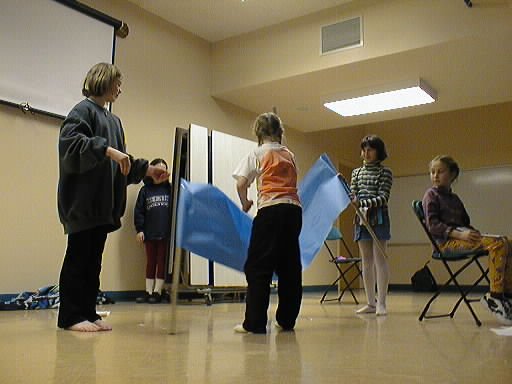
1. What do you know about Northwest Coastal Native Americans?
4. Read story Salmon Boy (story reprinted under these questions).
Long ago, among
the Haida people, there was a boy who showed no respect for the salmon.
Though the salmon meant life for the people, he was not respectful of the
one his people called Swimmer. His parents told him to show gratitude and
behave properly, but he did not listen. When fishing he would step on the
bodies of the salmon that were caught and after eating he carelessly threw
the bones in to the bushes. Others warned him that the spirits of the salmon
were not pleased by such behavior, but he did not listen.
One day, his
mother served him a meal of salmon. He looked at it with disgust. "This
is moldy," he said, though the meat was good. He threw it upon the ground.
Then he went down to the river to swim with the other children. However,
as he was swimming, a current caught him and pulled him away from the others.
It swept him into the deepest water and he could not swim strongly enough
to escape from it. He sank into the river and drowned.
There, deep
in the river, the Salmon People took him with them. They were returning
back to the oceans without their bodies. They had left their bodies behind
for the humans and animal people to use as food. The boy went with them,
for now he belonged to the salmon.
When they reached
their home in the ocean, they looked just like human beings. Their village
there in the ocean looked much like his own home and he could hear the
sound of children playing in the stream which flowed behind the village.
Now the Salmon People began to teach him. He was hungry and they told him
to go to the stream and catch one of their children, who were salmon swimming
in the stream. However, he was told, he must be respectful and after eating
return all of the bones and everything he did not intend to eat to the
water. Then, he was told, their children would be able to come back to
life. But if the bones were not returned to the water, the salmon child
could not come back.
He did as he
was told, but one day after he had eaten, when it came time for the children
to come up from the stream, he heard one of them crying, he went to see
what was wrong. The child was limping because one of its feet was gone.
Then the boy realized he had not thrown all of the fins back into the stream.
He quickly found the fin he had missed, threw it in and the child was healed.
After he had
spent the winter with the Salmon People, it was spring and time for them
to return to the rivers. The boy swam with them, for he belonged to the
Salmon People now. When they swam past his village, his own mother caught
him in her net. When she pulled him from the water, even though he was
in the shape of a salmon, she saw the copper necklace he was wearing. It
was the same necklace she had given her son. She carried Salmon Boy carefully
back home. She spoke to him and held him and gradually he began to shed
his salmon skin. First his head emerged.
Salmon Boy taught
the people all of the things he had learned. He was a healer now and helped
them when they were sick. "I cannot stay with you long," he said, "you
must remember what I teach you."
he remained
with the people until the time came when the old salmon who had gone upstream
and not been caught by the humans or by the animal people came drifting
back down toward the sea. As Salmon Boy stood by the water, he saw a huge
old salmon floating down toward him. He was so worn out by his journey
that he could see through its sides. He recognized it as his own soul and
he thrust his spear into it. As soon as he did, he died.
Then the people
of his village did as he had told them to do. They placed his body into
the river. It circled four times and then sank, going back to his home
in the ocean, back to the Salmon People.
The class continued on with their NW Coastal Native study
and salmon education by making up legends about the creation of our natural
world.